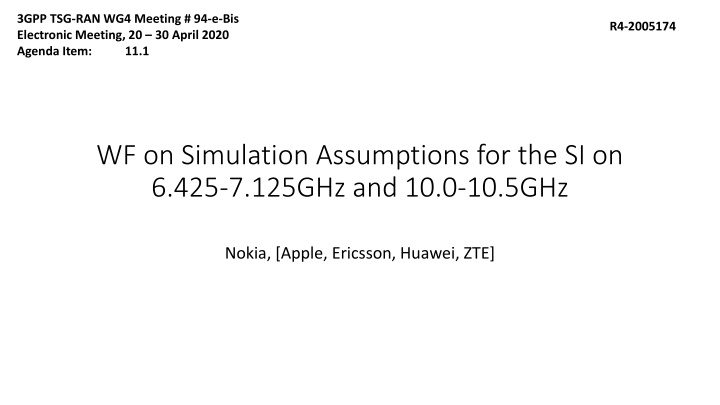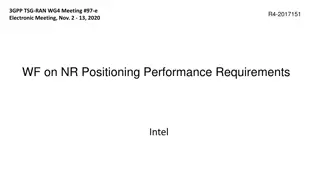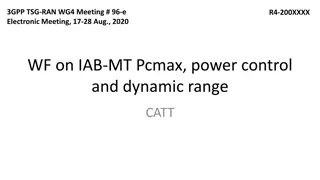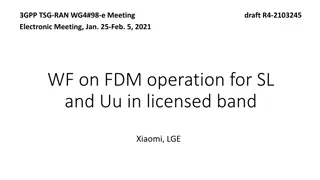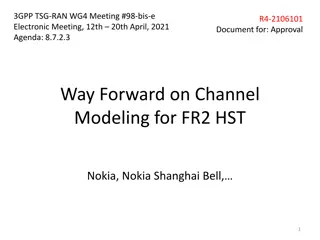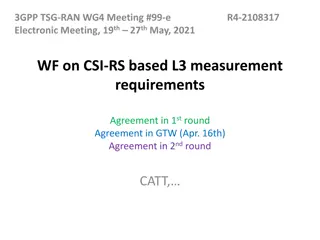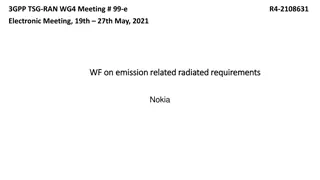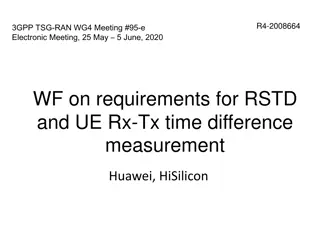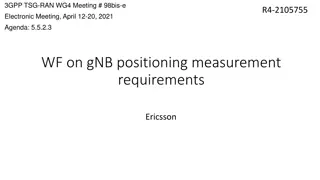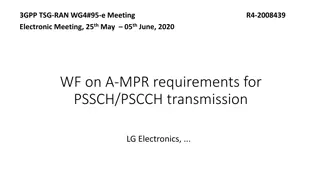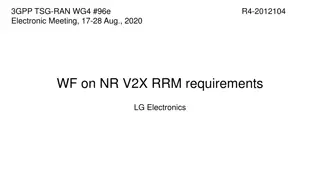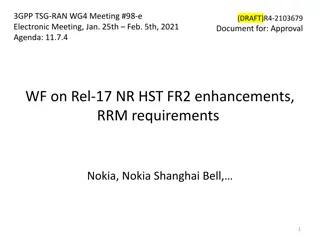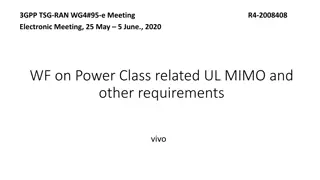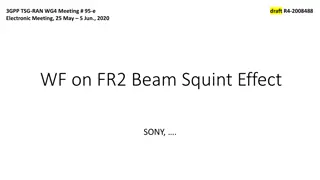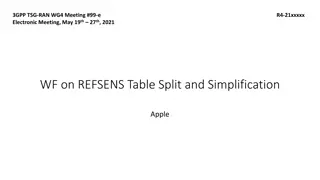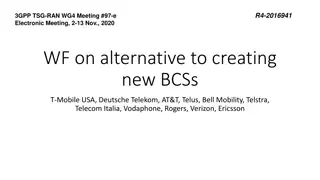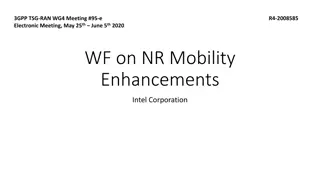3GPP TSG-RAN-WG4 Meeting #94 on Simulation Assumptions for Frequency Range Study
Background contributions and way forward on simulation assumptions for RAN4#94-e-Bis meeting focusing on frequency ranges 6.425-7.125GHz and 10.0-10.5GHz. The meeting discusses deployment scenarios, system level simulation methodology, IMT parameters, and various simulation assumptions provided by Nokia, Ericsson, Huawei, and ZTE. Topics include urban macro layouts, multi-operator coordination, channel bandwidth, propagation models, power controls, antenna characteristics, and more.
Download Presentation

Please find below an Image/Link to download the presentation.
The content on the website is provided AS IS for your information and personal use only. It may not be sold, licensed, or shared on other websites without obtaining consent from the author.If you encounter any issues during the download, it is possible that the publisher has removed the file from their server.
You are allowed to download the files provided on this website for personal or commercial use, subject to the condition that they are used lawfully. All files are the property of their respective owners.
The content on the website is provided AS IS for your information and personal use only. It may not be sold, licensed, or shared on other websites without obtaining consent from the author.
E N D
Presentation Transcript
3GPP TSG-RAN WG4 Meeting # 94-e-Bis Electronic Meeting, 20 30 April 2020 Agenda Item: 11.1 R4-2005174 WF on Simulation Assumptions for the SI on 6.425-7.125GHz and 10.0-10.5GHz Nokia, [Apple, Ericsson, Huawei, ZTE]
Background Contributions on simulation assumptions for the SI on 6.425-7.125GHz and 10.0-10.5GHz in RAN4#94-e-Bis: [1] R4-2003003->R4-2004951, System level simulation methodology and assumptions for study on IMT parameters for frequency ranges 6.425- 7.125GHz and 10.0-10.5GHz , Nokia, Nokia Shanghai Bell. [2] R4-2004128, SI on IMT parameters - simulation assumptions , Ericsson. [3] R4-2004539, IMT technology - 6.425-7.025GHz and 7.025-7.125GHz simulation parameters , Huawei. [4] R4-2004540, IMT technology 10-10.5 GHz simulation parameters , Huawei.
Way forward on Simulation Assumptions (Agreed) Deployment scenario Urban macro Layout TR 38.803 Multi-operators: Coordinated and uncoordinated Dense Urban: Layout TR 38.803 Multi-operators: coordinated Indoor Layout TR 38.803 Multi-operators: coordinated Channel Bandwidth 100 MHz Frequencies 7 GHz, 10 GHz Propagation model Path Loss TR 38.803 with UMa LOS formula from TR 38.901 LOS probability TR 38.803 O-to-I penetration loss TR 38.803 Tx power control TR 38.803 (May be further adjusted to target 15 UL SINR) Received power model TR 38.803 ACLR and ACS modeling TR 38.803 BS output power Max 43 dBm (Urban macro) UE power Max 23 dBm UE Noise figure 9 dB Handover margin 3 dB UE antenna Isotropic (0dBi) BS Antenna and beam forming See antenna characteristics
Way forward on Simulation Assumptions (To be agreed) Huawei Nokia Ericsson Tentative Remarks Deployment scenario Urban macro ISD 500m Urban: 450m Suburban : 900m 200m 450m ITU-R M.2292 (Macro Urban between 3 to 6 GHz) BS antenna height Urban: 20m 25m 20m ITU-R M.2292 (Macro Urban between 3 to 6 GHz) Suburban: 25m Dense Urban: Radius UE dropping <65m <28.9m 65m Calculated from 450m ISD Cell radius: 300 Radius UE dropping suburban <130m De-prioritized Dense Urban has the least demanding ACIR requirements among the three simulated scenarios in TR 38.803. Cell radius: 600 BS antenna height Priority 6m 10m Down-prioritized 6m Down-prioritized Dense Urban scenario instead 24 dBm (Dense Urban and Indoor) ITU-R M.2292 (Micro Urban between 3 to 6 GHz) Indoor scenario has the most demanding ACIR requirements among the three simulated scenarios in TR 38.803. ITU-R M.2292 (between 3 to 6 GHz) Indoor BS output power Max Dense urban: 33dBm Indoor: 23 dBm BS Noise figure 5 dB for macro base station 7dB 7 dB (Urban macro and dense urban) 7dB According to SI TR 38.820 on 7-24GHz UE power Min Max -40dBm -36 dBm -40dBm Used in TR 38.803, not dominant factor As optional case, CLx-ile may need to be adjusted Should we also consider 20dBm for the system simulations for 6.425-7.125GHz as proposed by Apple?
